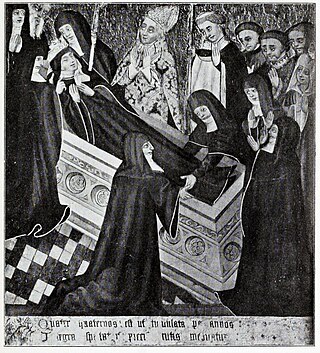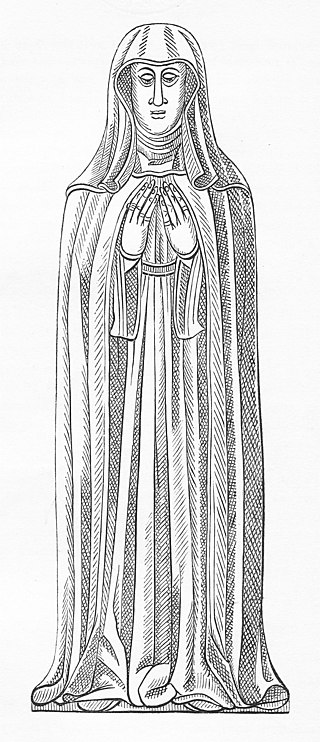
Shaftesbury Abbey was an abbey that housed nuns in Shaftesbury, Dorset. It was founded in about 888, and dissolved in 1539 during the English Reformation by the order of Thomas Cromwell, minister to King Henry VIII. At the time it was the second-wealthiest nunnery in England, behind only Syon Abbey.

Edith of Wessex was Queen of England from her marriage to Edward the Confessor in 1045 until Edward died in 1066. Unlike most English queens in the 10th and 11th centuries, she was crowned. The principal source on her life is a work she herself commissioned, the Vita Ædwardi Regis or the Life of King Edward who rests at Westminster, which is inevitably biased.

Edith of Wilton was an English saint, nun and member of the community at Wilton Abbey, and the daughter of Edgar, King of England and Saint Wulfthryth. Edith's parents might have been married and Edgar might have abducted Wulfthryth from Wilton Abbey, but when Edith was an infant, Wulfthryth returned with Edith and their marriage was dissolved. Edith and her mother remained at Wilton for the rest of their lives.

William Carey was a courtier and favourite of King Henry VIII of England. He served the king as a Gentleman of the Privy chamber, and Esquire of the Body to the King. His wife, Mary Boleyn, is known to history as a mistress of King Henry VIII and the sister of Henry's second wife, Anne Boleyn.

Godstow is about 2.5 miles (4 km) northwest of the centre of Oxford. It lies on the banks of the River Thames between the villages of Wolvercote to the east and Wytham to the west. The ruins of Godstow Abbey, also known as Godstow Nunnery, are here. A bridge spans the Thames and the Trout Inn is at the foot of the bridge across the river from the abbey ruins. There is also a weir and Godstow lock.

Seaxburh, also Saint Sexburga of Ely, was a Queen as well as an abbess, and is a saint of the Christian Church. She was married to King Eorcenberht of Kent.

Barking Abbey is a former royal monastery located in Barking, in the London Borough of Barking and Dagenham. It has been described as having been "one of the most important nunneries in the country".
Wherwell Abbey was an abbey of Benedictine nuns in Wherwell, Hampshire, England.
Dame Eleanor Carey was an early modern English noblewoman and nun, known for being endorsed as a candidate for abbess of Wilton Abbey by Anne Boleyn until her scandalous life was discovered.

Cecily Bodenham was the last abbess of Wilton Abbey. Her tenure as abbess was from 1534 to 25 March 1539, when she surrendered the abbey to the commissioners of King Henry VIII of England during the Dissolution of the Monasteries. She received a generous pension and a property at Fovant, where she retired with about ten of the nuns from Wilton.
Weohstan was the ealdorman of Wiltshire, part of the kingdom of Wessex, at the beginning of the ninth century. In 802 King Beorhtric died, and on the same day ealdorman Æthelmund of the Hwicce invaded Wiltshire. He was met by a Wiltshire army under Weohstan, which defeated the invasion and both ealdormen were killed in the battle.
Wulfthryth, also known as Wilfrida, was the second known consort of Edgar, King of England in the early 960s. Historians disagree whether she was his wife or mistress. Their daughter Edith was widely regarded in the eleventh century as a saint. In 964, Edgar married Ælfthryth, and then or earlier, Wulfthryth returned to Wilton Abbey, where she had been brought up, with her daughter. Wulfthryth remained there for the rest of her life as Abbess and died on 21 September in an unknown year, around 1000. She was regarded as a saint at Wilton, but her cult did not spread more widely.
Wulfhilda, also known as Wulfhild and Wulfreda among several other names, was an Anglo-Saxon abbess who is venerated as a saint in the Catholic Church.

John Stourton of Preston Plucknett in Somerset was seven times MP for Somerset, in 1419, 1420, December 1421, 1423, 1426, 1429 and 1435.

Agnes Jordan was the last pre-reformation Abbess of Syon Monastery. It was she who had to sign the deed of surrender on 25 November 1539 which brought to an abrupt end the life of the abbey and granted all its property and wealth to Henry VIII. She was the sister of Isabel Jordan, prioress and later abbess of Wilton Abbey.
Isabel Jordayne was an English abbess of Wilton Abbey. She was the penultimate abbess whose election was debated by Cardinal Wolsey and Anne Boleyn before Henry VIII, the abbey's patron, chose her.
Euphemia de Walliers was a Benedictine nun of Flemish descent who became the abbess of Wherwell Abbey. She is known for building and rebuilding at the abbey whilst the number of nuns rose by 40 to 80 during her management.
Edith Wilton was an English prioress at Carrow Abbey in Norwich.
Margaret Pygot was an English prioress of Carrow Abbey. She put the Abbey on a firm financial footing.











